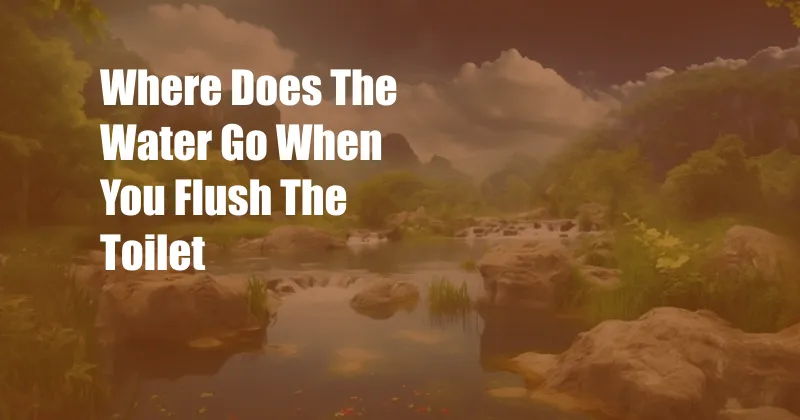
Where Does the Water Go When You Flush the Toilet?
As children, we all had the irresistible urge to watch water whirl down the drain after flushing the toilet. But have you ever stopped to wonder where that water actually goes? The journey of toilet water is a fascinating one that involves a complex network of pipes, treatment plants, and natural waterways.
In this comprehensive guide, we’ll delve into the intricate process of wastewater management and explore every step involved in the path of toilet water. From its initial surge through the pipes to its eventual release back into the environment, we’ll unravel the remarkable journey of this essential resource.
Sewage System: The Unsung Hero
Once you flush the toilet, the water carries your waste down through the plumbing system into a network of underground pipes called the sewage system. These pipes are designed to transport wastewater, including toilet waste, kitchen runoff, and laundry water, to treatment plants.
The sewage system is a crucial component of modern cities, ensuring the safe and efficient disposal of wastewater. It helps prevent the spread of disease, protects water sources from contamination, and plays a vital role in maintaining public health.
Wastewater Treatment: The Science Behind Clean Water
The wastewater collected from the sewage system is transported to treatment plants, where it undergoes a multi-step purification process. The primary goal of wastewater treatment is to remove contaminants, pathogens, and other harmful substances to produce clean water that can be safely discharged back into the environment.
The wastewater treatment process typically involves three main stages: primary, secondary, and tertiary treatment. Primary treatment involves physical processes like screening and settling to remove large particles and solids. Secondary treatment utilizes biological processes to break down organic matter and reduce the levels of harmful bacteria. Finally, tertiary treatment employs advanced technologies like filtration and disinfection to further purify the water and remove any remaining contaminants.
The Return to the Environment
After undergoing rigorous treatment at the wastewater plant, the water is now free from most contaminants and safe to be released back into the environment. The treated water can be discharged into rivers, streams, or lakes, where it replenishes natural water sources and supports aquatic life.
In some cases, treated wastewater may also be reused for non-potable purposes such as irrigation or industrial uses. This practice, known as water reclamation, helps conserve valuable freshwater resources and reduce the strain on natural water sources.
Tips for Responsible Wastewater Management
While the wastewater treatment system is remarkably efficient, it’s important for individuals to do their part in responsible wastewater management. Here are a few tips to help you minimize the amount of contaminants entering the sewage system:
- Dispose of chemicals properly: Household chemicals like pesticides, cleaning agents, and paints should never be flushed down the toilet. Instead, dispose of them at designated hazardous waste collection sites.
- Limit flushable wipes: While some wipes are marketed as flushable, they can still clog pipes and interfere with the treatment process. Stick to traditional toilet paper and dispose of wipes in the trash.
- Conserve water: To reduce the amount of wastewater generated, implement water-saving practices like installing low-flow toilets and taking shorter showers.
FAQs on Wastewater Management
Q: Why is it important to treat wastewater?
A: Untreated wastewater contains harmful contaminants that can pollute water sources, spread disease, and harm aquatic life. Wastewater treatment is essential to protect public health and the environment.
Q: What is the difference between primary and secondary wastewater treatment?
A: Primary treatment physically removes solids and large particles, while secondary treatment breaks down organic matter using biological processes.
Q: What happens to the sludge produced during wastewater treatment?
A: Sludge is the solid waste generated during the treatment process. It can be treated and applied to land as a fertilizer or incinerated to generate energy.
Conclusion
The journey of toilet water is a testament to the remarkable infrastructure and scientific advancements that ensure our cities remain clean and healthy. From the initial flush to the final release back into the environment, each step in the wastewater management process plays a crucial role in protecting water sources, preventing disease, and safeguarding our planet.
We encourage you to learn more about the fascinating world of wastewater management and take an active role in responsible disposal practices. By working together, we can ensure that our communities have access to clean water for generations to come.